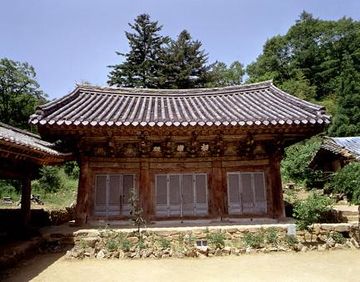완주 화암사 극락전
| 완주 화암사 극락전 Geungnakjeon Hall of Hwaamsa Temple, Wanju |
|
 완주 화암사 극락전, 국가문화유산포털, 문화재청. |
|
| 대표명칭 | 완주 화암사 극락전 |
|---|---|
| 영문명칭 | Geungnakjeon Hall of Hwaamsa Temple, Wanju |
| 한자 | 完州 花巖寺 極樂殿 |
| 주소 | 전라북도 완주군 화암사길 271 (경천면, 화암사) |
| 지정(등록) 종목 | 국보 제316호 |
| 지정(등록)일 | 2011년 11월 28일 |
| 분류 | 유적건조물/종교신앙/불교/불전 |
| 시대 | 조선시대 |
| 수량/면적 | 1동 |
| 웹사이트 | 완주 화암사 극락전, 국가문화유산포털, 문화재청. |
|
|
|
해설문
국문
극락전은 죽은 이를 서방 극락세계로 인도하여 그의 영혼을 구제하는 아미타불을 모시는 곳이다.
화암사 극락전은 고려 충렬왕 23년(1297)에서 충렬왕 복위 9년(1307) 간에 건물을 다시 새롭게 지었다가, 조선 세종 7년(1425)에서 세종 22년(1440) 간에 고쳐서 지은 것으로 추정된다. 선조 30년(1597) 정유재란 때 불탄 건물을 선조 38년(1605) 다시 세웠고, 이후에도 여러 차례 고쳤으며, 2004년 해체 보수하였다.
화암사 극락전은 우리나라에 흔치 않은 하앙식(下昻式) 건물이다. 하앙이란 기둥과 지붕 사이에 끼운 긴 서까래를 처마와 나란히 경사지게 놓아 지붕의 하중을 분산시켜 일반 지붕의 구조보다 처마를 훨씬 길게 늘여 뺀 건축방식이다. 중국이나 일본에서는 많이 볼 수 있는 구조이지만, 우리나라에서는 보기 드문 것으로 목조건축 연구에 귀중한 양식이다.
건물 편액은 한 글자씩 나누어 걸었다. 하앙의 기본 뼈대를 이루는 목재 재료 때문에 공간이 부족해서 이렇게 했다는 설도 있으나, 편액 위에 그려진 불화를 살리기 위해서라는 이야기도 있다.
전각 안에는 부처의 상을 모셔놓은 불단을 화려하게 만들었고, 법당의 불좌 위에 만들어 다는 닫집과 나한도와 화조도 등 벽화와 단청들이 화사하며, 아미타삼존불상을 중심으로 철종 9년(1858)에 갖춘 아미타후불도와 신중도, 현왕도 등과 화암사 동종(전라북도 유형문화재 제40호)이 있다.
영문
Geungnakjeon Hall of Hwaamsa Temple, Wanju
Geungnakjeon is a Buddhist worship hall honoring Amitabha, the Buddha of Western Paradise, who guides those who have died to be reborn in the Buddhist paradise of the West. It is the main worship hall of Hwaamsa Temple.
It is uncertain when this hall was first built, but it is presumed to have been rebuilt between 1297 and 1307 and repaired between 1425 and 1440. In 1597, during the Japanese invasions of 1597-1598, it was destroyed by fire and was reconstructed in 1605. Afterward, it underwent several repairs, and in 2004, it was dismantled and renovated.
The purlins of this building extend beyond its exterior walls, thus dispersing the weight of the roof and better supporting the rafters. This allows the eaves of the roof to extend significantly longer than a typical roof. This structure is a common feature of traditional Chinese and Japanese wooden buildings, but not of Korean buildings. Thus, this hall is regarded as a valuable resource in the study of traditional wooden architecture.
The hall’s name is written across three separate hanging plaques rather than on one as is custom. This may have been done because there was not enough space due to the structure of the roof or in order to avoid covering the Buddhist paintings above the wooden plaques.
Inside the hall, there is an ornate Buddhist altar upon which a triad, consisting of Amitabha and two attendant bodhisattvas, sits. Behind the triad is a painting of Amitabha, and above it is an intricate wooden canopy. The ceiling and walls of the hall are painted with colorful patterns and murals of flowers, birds, and arhats (the perfected disciples of the Buddha). Hanging on the walls are paintings depicting Guardian Deities and The King of Hell. The bronze bell of Hwaamsa Temple (Jeollabuk-do Province Tangible Cultural Heritage No. 40) is also enshrined in the hall.
영문 해설 내용
극락전은 죽은 이를 서방 극락세계로 인도하여 그의 영혼을 구제하는 아미타불을 모시는 곳이다. 화암사의 주불전이다.
화암사 극락전이 처음 지어진 시기는 알 수 없다. 1297년에서 1307년 사이에 다시 새롭게 지었다가, 1425년에서 1440년 사이 고쳐 지은 것으로 추정된다. 1597년 정유재란 때 불탄 것을 1605년에 재건하였고, 이후에도 여러 차례 고쳤으며, 2004년 해체 보수하였다.
화암사 극락전에서는 기둥과 지붕 사이에 끼운 긴 서까래를 처마와 나란히 경사지게 놓아 지붕의 하중을 분산시키고 있고, 일반 지붕에 비해 처마를 훨씬 길게 늘여 뺐다. 이러한 구조는 중국이나 일본의 목조 건물에서는 많이 볼 수 있지만, 한국 전통 목조 건물에서는 흔치 않은 것으로 목조 건축 연구에 귀중한 자료가 되고 있다.
건물 정면에는 건물 이름을 한 글자씩 나누어 쓴 현판 3개가 걸려 있다. 보통 하나의 현판에 전체 이름을 쓰는 것과는 다른 형태이다. 이렇게 한 이유에 대해서는 두 가지 설이 있는데, 지붕 구조 때문에 공간이 부족했기 때문이라는 설과, 편액 위에 그려진 불화를 가리지 않기 위해서라는 설이 있다.
전각 내부에는 화려한 불단과 닫집, 나한도와 화조도 등 벽화와 단청들이 화려하게 장식되어 있다. 불단에는 아미타삼존불상을 중심으로 아미타후불도, 신중도, 현왕도 등과 화암사 동종(전라북도 유형문화재 제40호)이 있다.
참고자료
- 완주 화암사 극락전’ 국보 지정 예고, 천지일보, 2011.9.8. 기사 https://www.newscj.com/news/articleView.html?idxno=94724
- 디지털완주문화대전 http://wanju.grandculture.net/wanju/toc/GC07000398
- 화암사 극락전 실측 및 수리보고서, 문화재청-완주군, 2004. →건물 관련 기본 정보 확인
- 전라북도 관광 https://tour.jb.go.kr/board/view.do?skinId=SKIN_0000003&boardId=BBS_0000005&menuCd=DOM_000000102004008000&startPage=1&dataSid=43052 →극락전이 지어진 때는 고려 후기인 1297년에서 1307년 사이, 그 후 중창된 것은 1425년에서 1440년으로 추정되었다. 또 정유재란 때 극락전이 화재로 소실되었다가 1605년에 재건되고, 1714년에 다시 보수했다는 것이 확인되었다.
- 봄꽃이 지면 산허리엔 수십 가지 녹색들이 피어난다, 오마이뉴스, 20.5.22. 기사 http://www.ohmynews.com/NWS_Web/View/at_pg_w.aspx?CNTN_CD=A0002641818 →건물 현황 및 '하앙 구조' 사진으로 확인 가능
- 이야기가 있는 옛 懸板을 찾아서-완주 화암사 ‘극락전’, 영남일보, 2012. 12.26. 기사 https://www.yeongnam.com/web/view.php?key=20121226.010200734580001 →현판이 다른 곳과 달리 한 글자씩 나누어져 달려있음. 기사 참조하여 현판 형태에 대한 설명 덧붙임.
- 알쓸신잡(개인블로그) https://ch-dindong.tistory.com/35?utm_source=dable →‘하앙구조’ 쉬운 설명
- 문화콘텐츠닷컴 http://www.culturecontent.com/content/contentView.do?search_div=CP_THE&search_div_id=CP_THE007&cp_code=cp0501&index_id=cp05010077&content_id=cp050100770001&search_left_menu=3 → 동종 관련 정보